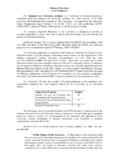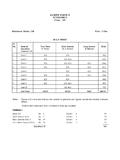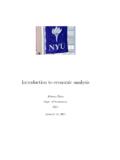Transcription of VOLUME 1 MARCH ISSUE COMPETITION LAW CIRQUE
1 VOLUME1 MARCH ISSUE1 COMPETITIONLAWCIRQUENATIONALLAWUNIVERSIT YJODHPUREDITORIAL ADVISORY BOARDMR. JOHN PHEASANT MS. PALLAVI S SHROFF MR. ARSHAD (PAKU) KHAN MR. MANAS CHAUDHURIPEER REVIEW BOARDMR. JOHN PHEASANT MR. ARSHAD (PAKU) KHAN MR. HARMAN SINGH SANDHUCHIEF PATRONPROF. POONAM SAXENAFACULTY ADVISORMR. SOUVIK CHATTERJIEDITOR-IN-CHIEFMANISHA SINGHEDITORS(EXECUTIVE) (SENIOR) (MANAGING)
2 KRITI AMAN KHERA RATHIN SOMNATH ASSOCIATE EDITORSSUSHMITASUR ANKITA SINGHARATRIKA CHAKRABORTY SUKANYA BHATTACHARYA CONTENTS1. LEGAL AND ECONOMIC REVIEWS OF CARTELS IN AIRLINE INDUSTRY- A CRITICAL ANALYSIS BY PRITANSHU SHRIVASTAVA & ANURAG THE CALL FOR CRIMINAL SANCTIONS FOR ENFORCEMENT OF COMPETITION LAW AND ITS PRACTICAL CONCERNS BY DR.
3 ANEESH V. PILLAI ..263. INVESTIGATING PETROLEUM INDUSTRY OF INDIA WITH RESPECT TO ALLEGED COMPETITION LAW VIOLATIONS BY UJJAWAL SATSANGI & SOURAV INDIAN SHIPPING EXEMPTION: A COMPARATIVE ANALYSIS BY ARAHANT JAIN & SHUBHA INDIAN COMPETITION (AMENDMENT ) ACT, 2007 HAS NOT MADE DIFFERENCE BETWEEN PER SE RULE AND RULE OF REASON BY SOUVIK 1 LEGAL AND ECONOMIC REVIEW OF CARTELS IN AIRLINE INDUSTRY ACRITICAL ANALYSIS PRITANSHU SHRIVASTAVA1 AND ANURAG GUPTA2 ABSTRACTThe COMPETITION Act 2002 prohibits vertical and horizontal agreements that have an appreciable adverse effect on the COMPETITION .
4 The Indian Aviation Sector being an oligopoly market has tendency of collusion amongst its players thereby proving detrimental to the consumers and social welfare at an oligopoly the products may be homogeneous or differentiated. Oligopolies are able to set prices (they have market-making power) but they also compete with other firms in the industry based on product the present paper the Authors have discussed the law and economics of cartels in an oligopolistic market and the effects thereof. Also, the nature, scope and effect of cartels in airline industry in India and at the end of the article suggested few measures to fight the menace of cartelisation in the PROLOGUE People of the same trade seldom meet together, even for merriment and diversion, but the conversation ends in a conspiracy against the public, or in some contrivance to raise prices.
5 Adam Smith, The Wealth of Nations, 1776 Airplane, one of the greatest inventions of all times, has given way to the growth of the Air Industry or the Civil Aviation Sector all over the globe. It is now well recognized that the there is a link between civil aviation and economic activity and it has a catalytic impact on general development. (H) & Economics and currently practicing in the Delhi High (H) & Company Secretary and currently practicing in the Calcutta High $100 spent on air transport produces benefits worth $325 billion to the economy.
6 It generates 100 additional jobs in air transport and 610 related aviation sector in India is rapidly gaining importance. It is estimated that foreign exchange transactions of $ billion are directly facilitated by civil aviation and another $96 billion indirectly through civil aviation services. 95% of tourist arrivals are by air. Airports facilitate growth of high-value and perishable trade; 40% of exports and imports in India by value are carried by air. The sector might one day also serve to routinely provide connectivity to remote areas otherwise inaccessible by other modes of industry all over the world has been considered as an oligopolistic market market dominated by a few firms which are large enough to influence the market size, due to their capital intensive nature and policy restrictions5.
7 In oligopolistic market there is a natural tendency to collude between enterprises. Since, it is a form of industry (market) structure characterised by a few firms where products may be homogenous or differentiated. The behaviour of any one firm in an oligopoly depends to a great extent on the behaviour of others. So, with collusion, oligopolistic firms can avoid behaviour that is detrimental to their general interest price war. Therefore, there is a high tendency of oligopolists forming a cartel. Same can be seen in the aviation industry throughout the world. A cartel is a formal organization of similar, independent companies who make joint decisions to fix prices, limit production or to share markets or customers between them.
8 Instead of competing with each other, cartel members rely on each others agreed course of action which reduces their incentives to provide new or better products and services at competitive to economists a number of conditions need to be present, for a cartel to demand for the product for which Cartel is formed in the market must be such that changes in price have a relatively small effect on the quantity of the goods demanded inelastic. Availability of substitutes in the market makes the increase in the cartel s price self defeating as buyers shift to the available cheaper substitutes.
9 3 (Last visited September 11, 2013).4 Ministry of Civil Aviation, Government of India, A Road Map for Civil Aviation Sector, Report of the Civil Aviation Committee, October, 2004 available (Last visited September 11, 2013).5 See (Last visited September 8, 2013)6 KARL E. CASE AND RAY C, FAIR, PRINCIPLES OF ECONOMICS, 342 (Prentice Hall Business Publishing). members of the Cartel must work within the rules of the group. There are always big incentives for the members to break out, cheat by increasing the output and making huge main purpose of forming cartels is to coordinate the policies of member firms to increase the such cartels are held to be anticompetitive by COMPETITION laws of almost all the countries including COMPETITION Act, 2002 of India (henceforth referred as the Act ).
10 This article will focus on the recent trends in airline industry and will show the tendency to enter into cartels all over the world including India. For example, in October 16, 2005 honchos of 11 airlines met in Mumbai to form the Federation of Indian Airlines (FIA) that will provide a common platform to debate industry issues and lobby the government and hammer out solutions. However, at the very first meeting they were discussing about pricing issues, which was timely brought to the notice of the CCI, and hence the very first step towards cartelization was aborted. Earlier, there had been chances of coordination in prices which might become even higher if the Proposed Alliance between AI and Jet had ECONOMICS OF INDIANAIRLINE INDUSTRY: THE OLIGOPOLY MARKETIn the present article, it has been previously mentioned that Indian Aviation sector has an oligopoly market structure, therefore, the authors claim that like all oligopolistic or concentrated industries, the Indian Aviation sector is likely to be inefficient, based on the following economics postulates:1.








